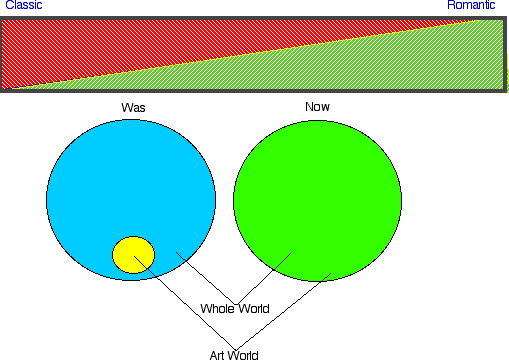|
After looking at the art of Pre-World War 2, spanning some 42,000 years of time, hopefully there are some recognizable trends that we can better understand. The first
trend is that the art world’s major art style to seem to swing on a pendulum that moves between classical and romantic
ideals (as seen in the chart below). For example, generations of artists develop a high ability in creating a lifelike image,
like the art that was made in ancient Greece and Rome. The next generation wanting to rebel against the old ways. Thus, we
see the Gothic era of more abstracted arts. Art then become more realistic in the Renaissance, more abstract during the Baroque,
more true to life during Neo-Classicism, and so the swing goes on.
Contemporary art is a very different trend, in that the art that has been produced in our modern times allows
that artist of today to choose where they fit on the range between very classical (or realistic) to very romantic (or abstracted).
This may because we all have been influenced in some way through the study of both sides, that we now choose a preferred side
or develop a hybrid art that combines parts of either side or multiple artist influences. The point is, art throughout the
range is accepted, marketable, and has a place.

The second trend, which we will more clearly see at this point, is where art fits into the whole world. Before World War
2, art was easy to identify. It hung ok a wall or sat on a base. The whole world was full of categories, of which art was
one (as seen in the diagram above). People of this time could ask a simple question in placing an item into this art world.
"What is art?"
It’s a radio, so its not art, but if it’s a drawing, then it is art. Life was so simple back then.
In today's world, largely due to the revolutionary ideas of Marcel Duchamp, have to ask a different question. "When is it art?" It’s
a radio in my room, so its not art. But if an identical radio in the Museum of Modern Art or used to make something by an
artist, like Nam June Paik, then it is art. The ability to classify art becomes very difficult because we have to not only consider the type of art
it is, but also decide if it is art at all based upon the context in which we see the object.
The Art World, now can include everything in the
Whole World.
New York became the art center for the world after World War 2.
Robert
Moris defined art through the 4 legs of the art table:
1. Marcel Duchamp-------Dada/Surrealism
2. Edward Hopper---------Scene Painter
3. Joseph Cornell----------Assemblage
4. Jackson Pollock---------Abstraction
This evolved into the 9 streams of today:
Art & Technology
Figuration
Geometric
Ab.
Gestural Ab.
Instillation, Environment, & Site
Language & Concept
Performance
Popular
Process
We will also cover OTHER important
artists that do not fit into a basic stream.
Many artists will overlap streams, but you may need to know examples
of artists and their stream as discussed in class.
|

